We closed this position on April 14, 2021. A copy of the associated Position Update report is here.
We recently highlighted two separate restaurant operators poised to excel during the widely-expected economic recovery. This week we’ve identified a third.
This casual dining firm has experienced major disruption to its operations, but investors who look past the temporary slowdown in business can still find great value long term. Bloomin’ Brands’ (BLMN: $11/share) is this week’s Long Idea.
Bloomin’ Brands’ History of Profit Growth
Over the past seven years, Bloomin’ Brands has grown revenue by 1% compounded annually and core earnings[1] by 1% compounded annually. More recently, Bloomin’ Brands has grown core earnings by 5% compounded annually since 2017, per Figure 1. The firm increased its core earnings margin from 2.9% in 2017 to 3.2% in 2019.
As expected, TTM core earnings took a dive and may get worse before they get better. Further, unlike most of our Long Ideas, this stock currently gets our Neutral rating, largely due to the impact of the dramatic decline in revenue and profitability in 1Q20 on trailing-twelve-month (TTM) results. Our Ratings on many of our stocks drop temporarily due the recent economic decline. Our thesis does not depend on profits growing as we explain in the valuation section of this report.
Figure 1: Core Earnings & Revenue Growth Were Rising before the Pandemic
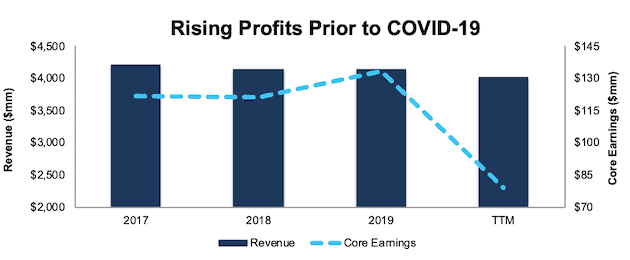
Sources: New Constructs, LLC and company filings.
Despite the current earnings trend, Bloomin’ Brands’ ability to generate significant free cash flow (FCF) has been impressive. The company generated positive FCF in five of the past 7 years and a cumulative $773 million (86% of market cap) in FCF over the past five years.
Ample Liquidity to Survive the Downturn
While COVID-19 has disrupted Bloomin’ Brands’ operations in the short term, the firm’s available liquidity positions it to weather the economic downturn. To help improve the firm’s cash balance, Bloomin’ Brands issued $202 million worth of convertible notes on May 6. As of June 11, 2020, the firm had $493 million of available liquidity. This includes $128 million of cash (including the remaining net proceeds from the convertible notes offer) and $365 million of capacity on the firm’s credit facility. During its 1Q20 earnings call, the firm estimated that its daily cash burn was ~$6 to $8 million per week.
To illustrate the firm’s strong cash position, we review a worst-case scenario, where Bloomin’ Brands generates no revenue and the firm’s cash burn is $8 million per week. In such a scenario, the firm could operate for over 15 months with its available liquidity before needing additional capital.
However, it’s highly unlikely that Bloomin’ Brands’ revenue would go to zero. Since the firm kept nearly all of its employees during the lockdowns it has been more prepared than most to reopen. On June 11, the firm reported that ~74% of its U.S. restaurants have reopened with limited in-restaurant dining capacity.
Furthermore, in its 1Q20 earnings call, the firm noted that it could be cash flow neutral with revenues down 20% to 25% from the prior year. Bloomin’ Brands is already approaching neutral cash flow levels. The firm’s combined U.S. comparable sales for stores open 18 months or more were down 28% for the week ending June 6, 2020.
As concerns of a second wave of COVID-19 increase, additional shelter-in-place orders pose the biggest threat to Bloomin’ Brands’ cash position. In the event of another round of shelter-in-place orders, the firm will be more prepared than it was the first time. Bloomin’ Brands’ improved capability to generate revenue in shelter-in-place conditions provides additional support for the firm’s already strong cash position.
Improving Profitability Helps Take Market Share During the Crisis and Grow in the Recovery
COVID-driven disruptions to the restaurant industry have already driven financially weaker operators out of business. Bloomin’ Brands’ profitability was growing at a faster rate than its competitors before the crisis, and the firm is well-positioned to grow profits when the economy recovers.
Per Figure 2, Bloomin’ Brands’ net operating profit after-tax (NOPAT) margin, has improved from 4.9% in 2017 to 5.6% TTM. Over the same time, the market-cap-weighted average of Bloomin’ Brands’ peer group has fallen from 8.4% in 2015 to 7.9% TTM. This peer group consists of 12 other full-service restaurants including Darden Restaurants, Inc. (DRI), Brinker International, Inc.(EAT), Cracker Barrel Old Country Store, Inc. (CBRL), Texas Roadhouse, Inc. (TXRH), and more.
Figure 2: NOPAT Margin Vs. Peers

Sources: New Constructs, LLC and company filings.
Bloomin’ Brands’ invested capital turns, a measure of balance sheet efficiency, have slightly fallen from 1.3 in 2015 to 1.2 TTM, per Figure 3. The peer group’s market-cap-weighted average invested capital turns have remained unchanged at 1.3 over the same time.
Figure 3: Invested Capital Turns Vs. Peers

Sources: New Constructs, LLC and company filings.
Bloomin’ Brands’ rising margins are enough to offset falling invested capital turns and help drive the firm’s improving return on invested capital (ROIC). Per Figure 4, Bloomin’ Brands’ ROIC improved from 6.5% in 2017 to 8.6% in 2019 while the market-cap- weighted average of peers’ ROIC increased from 10.3% to 10.5% over the same time.
Figure 4: ROIC vs. Peers

Sources: New Constructs, LLC and company filings.
Unless you believe that there will be no need for restaurants in a post-COVID-19 world, it’s hard to argue against Bloomin’ Brands’ ability to survive. And, if it survives, it’s hard to argue against the firm’s improving profitability before the crisis translating into more market share and profit growth after the crisis.
Bear Case Assumes Restaurant Industry Is in Permanent Decline
Bloomin’ Brands has obviously felt the effects of the COVID-19 pandemic. For the week ended June 6, 2020, the firm’s comparable restaurant sales were down 28% year-over-year (YoY). However, BLMN’s current share price implies that Bloomin’ Brands will never see revenue rebound from these levels.
Figure 5: Bloomin’ Brands’ Leading Two Brands Generate 78% of Sales
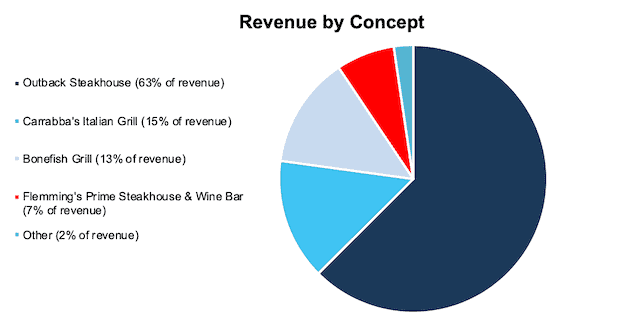
Sources: New Constructs, LLC and company filings.
To agree with the stock’s current valuation, one must ignore the strength of Bloomin’ Brands’ concepts, particularly since 2017, and the firm’s ability to attract and retain customers. Per Figure 6, Bloomin’ Brands’ combined U.S. comparable sales have increased YoY in four of the last five years. More recently, the firm’s concepts have grown comparable sales YoY in each year since closing several underperforming restaurants in 2017.
Figure 6: Bloomin’ Brands’ U.S. Comparable Sales

Sources: New Constructs, LLC and company filings.
Additionally, the firm’s biggest brand, Outback Steakhouse, has posted the largest YoY sales growth among all of its concepts every year except 2016.
The pandemic is also encouraging a new way for consumers to enjoy the firm’s food and service. The rise of Bloomin’ Brands’ off-premise business gives the firm opportunity to grow during and after the pandemic. While the firm was focused on growing this area of its business before the pandemic, it experienced rapid uptake as the shutdowns occurred across the country. Outback Steakhouse’s average weekly sales per restaurant grew by 213% from the weeks ended March 1, 2020 to May 3, 2020. See Figure 7 for more details. Bloomin’ Brands’ off-premise business has quickly become a major revenue stream that should continue after the pandemic.
Figure 7: Bloomin’ Brands’ Average Weekly Off-Premise Sales per U.S. Company-Owned Restaurant

Sources: New Constructs, LLC and company press releases.
In addition to helping the firm succeed through the pandemic, off-premise sales should help the firm reestablish its core dine-in service. Providing food service while other restaurants are completely closed, allows the firm to maintain and even grow its engagement with customers, which will be an advantage for the firm once the effects of the pandemic are over.
While comparable sales will certainly decline in 2020, we, along with the International Monetary Fund (IMF) and nearly every economist in the world, believe that U.S. GDP growth will be higher in 2021 than expected before the pandemic. The IMF estimates the U.S. economy will expand by 4.5% in 2021. Fitch Ratings projects the U.S. to reach “pre-virus levels of GDP” in mid-2022.
Accordingly, it is safe to assume the restaurant business will return to something, at a minimum, approaching historical levels. In which case, Bloomin’ Brands is well-positioned to capitalize on the long-term demand to eat out, increase its profitability, and take the market share left by the restaurants that do not survive or adapt to industry changes as well as the firm has.
Bloomin’ Brands Capital Re-Allocation Strategy Is Working
In 2017, Bloomin’ Brands decided to close 43 (3% of the 1,276 company-owned stores in 2016) underperforming restaurants. This closure obviously hurt revenue and profits in the short term, but allowed the firm to focus on building its brand. The firm made investments in technology infrastructure, a global supply chain management system to better forecast inventory, and systems to support its customer loyalty program. In just two years, as a more efficient and profitable firm, Bloomin’ Brands exceeded its 2016 profit levels.
The firm was already looking at divesting its Brazil business before those plans were temporarily affected by the pandemic. The COVID-19 shutdowns could also prove to be the right time for the firm to reevaluate other parts of its business as it seeks to further improve profitability. For example, the lessons the firm has learned through the pandemic with its digital and off-premise business can be used going forward and make Bloomin’ Brands more efficient.
Market Share for the Taking after COVID-19
Many restaurants have not survived the current crisis. A study in late March conducted by the National Restaurant Association found that 11% of restaurant owners and operators anticipated they would permanently close within the next 30 days. According to the Texas Restaurant Association, that expectation was accurate for Texas as 12% of restaurants in that state have permanently closed due to the pandemic.
Bloomin’ Brands financial position, growing off-premise service, and well-known brands provide an excellent opportunity to gain market share during and after the COVID-19 pandemic.
BLMN Is Undervalued
After falling 50% year-to-date (YTD) to $11/share, BLMN now trades significantly below its economic book value, or no-growth value, and at its cheapest price-to-economic book value (PEBV) ratio (0.6) in the history of our model. This ratio means the market expects Bloomin’ Brands’ NOPAT to permanently decline by 40%. This expectation seems overly pessimistic over the long term. For reference, Bloomin’ Brands has grown NOPAT by 2% compounded annually since 2012.
Bloomin’ Brands’ current economic book value is $17/share – a 55% upside.
Figure 8: Stock Price vs. Economic Book Value (EBV)
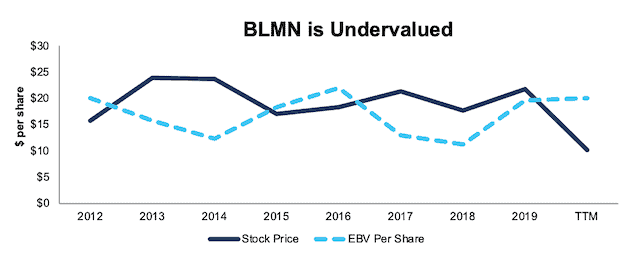
Sources: New Constructs, LLC and company filings.
BLMN’s Current Price Implies No Economic Recovery
Bloomin’ Brands is priced as if the COVID-driven economic decline will permanently depress its profits. Below, we use our reverse DCF model to quantify the cash flow expectations baked into Bloomin’ Brands’ current stock price. Then, we analyze the implied value of the stock based on different assumptions about COVID-19’s impact on the economy and Bloomin’ Brands’ future growth in cash flows.
Scenario 1: Using historical revenue declines, historical margins, and average historical GDP growth rates, we can model the worst-case scenario already implied by Bloomin’ Brands’ current stock price. In this scenario, we assume:
- NOPAT margins fall to 5% (all-time low in 2017, compared to 7% in 2019) in 2020-2021 and increase to 6% (all-time average) in 2022 and each year thereafter
- Revenue falls 27% (vs consensus of -21% and equal to the worst-case scenario proposed by Technomic, a foodservice industry research provider) in 2020 and does not grow in 2021 (vs consensus of 18%)
- Sales begin growing again in 2022, but only at 3.5% a year, which is the average global GDP growth rate since 1961
In this scenario, where Bloomin Brands’ NOPAT declines 3% compounded annually over the next eight years (including a 45% YoY drop in 2020), the stock is worth $11/share today – nearly equal to the current stock price. This scenario also accounts for the debt issuance since the end of 1Q20 noted earlier. We conservatively assume this capital will be used to cover operating expenses and do not treat it as excess cash. See the math behind this reverse DCF scenario.
For reference, when Bloomin Brands decided in 2017 to close 43 underperforming restaurants, the firm’s NOPAT fell 14% YoY before growing 14% compounded annually over the following two years.
Figure 9 compares the firm’s implied future NOPAT to its historical NOPAT in this scenario. This worst-case scenario implies Bloomin Brands’ NOPAT eight years from now will be 22% below its 2019 NOPAT. In other words, this scenario implies that a decade after the COVID-19 pandemic, Bloomin Brands’ profits will have only recovered to just 1% above 2017 NOPAT levels – the lowest levels since the firm’s IPO in 2012 and prior to the closure of underperforming restaurants. In any scenario better than this one, BLMN holds significant upside potential, as we’ll show below.
Figure 9: Current Valuation Implies Severe, Long-Term Decline in Profits: Scenario 1
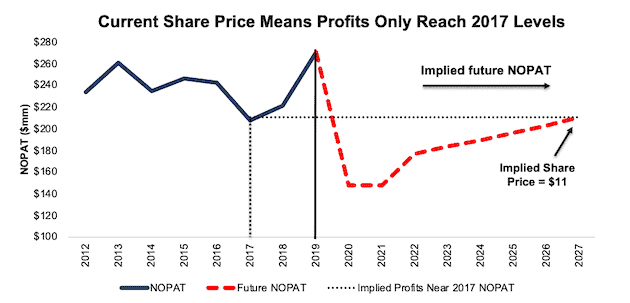
Sources: New Constructs, LLC and company filings.
Scenario 2: Long-term View Could Be Very Profitable
If we assume, as does the International Monetary Fund (IMF) and nearly every economist in the world, that the global economy rebounds and returns to growth starting in 2021, BLMN is undervalued.
In this scenario, we assume:
- NOPAT margins fall to 5% (all-time low in 2017, compared to 7% in 2019) in 2020 and increase to 6% (all-time average) in 2021 and each year thereafter
- Revenue falls 27% (vs consensus of -21% and equal to the worst-case scenario proposed by Technomic, a foodservice industry research provider) in 2020 and grows at 12% in 2021 (well below consensus of 18%)
- Sales grow from 2022 onward at 3.5% a year, which is the average global GDP growth rate since 1961
In this scenario, Bloomin’ Brands’ NOPAT falls by 1% compounded annually over the next decade (including a 45% YoY drop in 2020) and the stock is worth $18/share today – a 64% upside to the current price. This scenario also accounts for the debt issuance since the end of 1Q20 noted earlier. We conservatively assume this capital will be used to cover operating expenses and do not treat it as excess cash. See the math behind this reverse DCF scenario.
For comparison, Bloomin’ Brands has grown NOPAT by 14% compounded annually over the past two years and 3% compounded annually over the past five years. It’s not often investors get the opportunity to buy a growing company at such a discounted price.
Figure 10 compares the firm’s implied future NOPAT to its historical NOPAT in scenario 2. This moderate scenario implies that a decade from now, Bloomin’ Brands’ NOPAT will be 7% below 2019 levels and slightly less than the NOPAT earned in 2013. If profits return to these levels in less than 10 years, BLMN has even more upside potential.
Figure 10: Implied Profits Assuming Moderate Recovery: Scenario 2
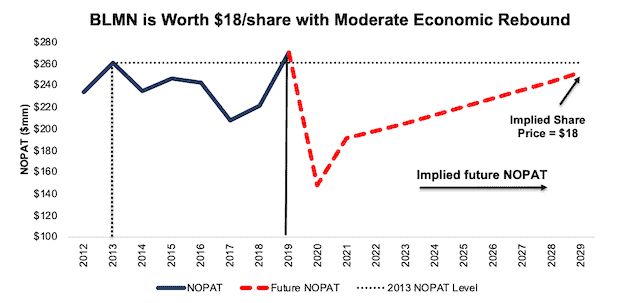
Sources: New Constructs, LLC and company filings.
Sustainable Competitive Advantages Will Drive Shareholder Value Creation
Here’s a summary of why we think the moat around Bloomin’ Brands’ business will enable it to continue to generate higher NOPAT than the current market valuation implies. The following competitive advantages help Bloomin’ Brands survive the downturn and return to growth as the economy grows again:
- Strong balance sheet to survive the economic dip
- Bloomin’ Brands’ successful digital presence and off-premise operations
- Growing profitability compared to its peer group
What Noise Traders Miss with Bloomin’ Brands
These days, fewer investors focus on finding quality capital allocators with shareholder friendly corporate governance. Instead, due to the proliferation of noise traders, the focus is on short-term technical trading trends while high-quality fundamental research is overlooked. Here’s a quick summary of what noise traders are missing:
- Recent core earnings growth before the pandemic
- Consistent same-store sales growth
- Valuation implies restaurant industry never recovers
The Yield Is on Hold, but Should Come Back
Bloomin’ Brands suspended its dividend program and share repurchase program in 1Q20.
Prior to the suspension, the firm had increased its dividend in five consecutive years. Over that time, the firm generated far more in in free cash flow ($773 million) than it paid out in dividends ($161 million), or an average $122 million surplus each year. Its last quarterly dividend, when annualized, equaled $0.80/share and provided a 7.3% yield.
Firms with cash flows greater than dividend payments have a higher likelihood to maintain and grow dividends. While Bloomin’ Brands suspended its dividend in the short term, investors buying at current prices should get a nice yield with upside potential as the firm reinstates the dividend over the long term.
Historically, Bloomin’ Brands has also returned capital to its shareholders through share repurchases. Bloomin’ Brands has repurchased $975 million (101% of current market cap) since 2015. A return to repurchasing shares once the economy stabilizes, or even returns to growth, would provide additional yield for investors.
A Consensus Beat or Signs of Recovery Could Send Shares Higher
According to Zacks, consensus estimates at the end of February pegged Bloomin’ Brands’ 2020 EPS at $1.82/share. Jump forward to June 19, and consensus estimates for Bloomin’ Brands’ 2020 EPS have fallen to -$1.44/share. 2021 estimates follow a similar trend. At the end of January, 2021 EPS consensus was $2.01/share, which has since fallen to $0.68/share.
Though the COVID-19 pandemic has reduced restaurant demand, these lowered expectations provide a great opportunity for a strong company, such as Bloomin’ Brands, to beat consensus. Our current Earnings Distortion Score, which is a short-term indicator of the likelihood to beat or miss expectations, for Bloomin’ Brands is “Beat.” The lowered expectations moving forward make it much easier for the firm to beat earnings.
The firm beat EPS estimates in seven of the past 10 quarters, and doing so again, in the midst of such market turmoil, could send shares higher.
Lastly, JANA Partners LLC has a 9.2% stake in Bloomin’ Brands. This investment management company has a history of taking similar sized stakes in companies such as PetSmart, Whole Foods, and Pinnacle Foods while actively pursuing buyers. In April, Bloomin’ Brands and JANA Partners agreed on two new nominees to the firm’s board of directors. Should JANA Partners find a suitable buyer for Bloomin’ Brands, shares could soar higher.
Executive Compensation Could Be Improved but Raises No Red Flags
No matter the macro environment, investors should look for companies with executive compensation plans that directly align executives’ interests with shareholders’ interests. Quality corporate governance holds executives accountable to shareholders by incentivizing them to allocate capital prudently.
In 2019, 65% to 85% of executive compensation was performance based. The firm’s short-term incentives were tied to targeted levels of total revenue growth, adjusted EPS, and adjusted operating income margin percentage.
Bloomin’ Brands’ long-term incentive plan rewards executives with performance share units for meeting a three-year average annual adjusted EPS growth target.
We would prefer the firm use ROIC improvement when determining executive compensation, as there is a strong correlation between improving ROIC and increasing shareholder value. Having accurate values for NOPAT and invested capital ensures investors have an apples-to-apples metric for measuring corporate performance and holds management accountable for every dollar invested into the company.
Despite not using ROIC when measuring performance, Bloomin’ Brands’ compensation plan has not compensated executives while destroying shareholder value. Bloomin’ Brands has grown economic earnings by 20% compounded annually over the past five years.
Insider Trading and Short Interest Trends
Over the past three months, insiders have bought a total of 25 thousand shares and sold 41 thousand shares for a net effect of 16 thousand shares sold. These sales represent less than 1% of shares outstanding.
There are currently 9.9 million shares sold short, which equates to 12% of shares outstanding and over two days to cover. Short interest is down 3% from the prior month. The high short interest increases the likelihood of a short-squeeze should positive news or an earnings beat occur.
Critical Details Found in Financial Filings by Our Robo-Analyst Technology
As investors focus more on fundamental research, research automation technology is needed to analyze all the critical financial details in financial filings as shown in the Harvard Business School and MIT Sloan paper, "Core Earnings: New Data and Evidence”.
Below are specifics on the adjustments we make based on Robo-Analyst findings in Bloomin’ Brands’ 2019 10-K:
Income Statement: we made $172 million of adjustments, with a net effect of removing $140 million in non-operating expenses (3% of revenue). You can see all the adjustments made to Bloomin’ Brands’ income statement here.
Balance Sheet: we made $1.2 billion of adjustments to calculate invested capital with a net increase of $425 million. One of the largest adjustments was $382 million in operating leases. This adjustment represented 15% of reported net assets. You can see all the adjustments made to Bloomin’ Brands’ balance sheet here.
Valuation: we made $3.5 billion of adjustments with a net effect of decreasing shareholder value by $3.3 billion. Apart from total debt which includes the operating leases mentioned above, the most notable adjustment to shareholder value was $8 million in minority interests. This adjustment represents 1% of Bloomin’ Brands’ market cap. See all adjustments to Bloomin’ Brands’ valuation here.
Attractive Fund That Holds BLMN
The following fund receives our Attractive rating and allocates significantly to BLMN:
- Snow Capital Small Cap Value Fund (SNWIX) – 2.1% allocation
This article originally published on June 24, 2020.
Disclosure: David Trainer, Kyle Guske II, and Matt Shuler receive no compensation to write about any specific stock, style, or theme.
Follow us on Twitter, Facebook, LinkedIn, and StockTwits for real-time alerts on all our research.
[1] Our core earnings are a superior measure of profits, as demonstrated in Core Earnings: New Data & Evidence a paper by professors at Harvard Business School (HBS) & MIT Sloan. The paper empirically shows that our data is superior to “Operating Income After Depreciation” and “Income Before Special Items” from Compustat, owned by S&P Global (SPGI).
